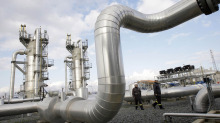Natural gas futures hit another 10-year low
 U.S. natural gas futures ended down Wednesday, with April hitting a 10-year spot low before expiration as record-high supplies, mild weather forecasts and expectations for a sizable inventory build on Thursday undercut prices for the third straight session.
U.S. natural gas futures ended down Wednesday, with April hitting a 10-year spot low before expiration as record-high supplies, mild weather forecasts and expectations for a sizable inventory build on Thursday undercut prices for the third straight session.Record-high temperatures in March have slowed heating demand and helped drive gas prices down 16 per cent so far this month, particularly with production running at or near all-time highs and inventories still at a record high for this time.
Front-month April gas futures on the New York Mercantile Exchange expired down 1.7 cents at $2.191 (U.S.) per million British thermal units after slipping early to $2.163, the lowest for the lead month since February 2002.
“Prices hit another new low, and I think that’s going to continue. There’s a lot of gas around, there’s not a lot of demand during the (spring) shoulder period,” a Pennsylvania-based trader said.
Spreads to winter contracts continued to widen, with the December premium to May edging slightly higher to 98.1 cents. That spread has spiked nearly 40 per cent so far this month as mild March weather slowed demand and pressured prompt months.
While recent gas drilling declines and planned production cuts by several producers have stirred expectations that bloated supplies might finally tighten, traders said the reductions were not nearly enough to soak up all of the excess supply.
Most expect more pressure on prices, at least until weather demand picks up.
AccuWeather.com expects temperatures in the Northeast and Midwest, key gas-consuming regions, to mostly average above normal for the next two weeks, with daytime highs at times climbing to 21 degrees Celsius.
HIGH PRODUCTION
Traders will be looking for some sign that record output is slowing when the Energy Information Administration on Thursday releases its gross natural gas production report for January.
In late February, the agency reported a slight drop for December, the first measurable decline since well freeze-offs curbed output in January and February 2011.
Gas prices failed to garner support last week from Baker Hughes data showing the gas-directed rig count fell for the 11th straight week to 652, its lowest since May 2002 when there were 640 rigs operating.
The steady decline in gas drilling has yet to be reflected in pipeline flows, which are still estimated to be at or near record high levels, primarily due to rising output from shale.
Some analysts say the gas-directed rig count may have to drop below 600 to reduce flowing supplies significantly, noting the producer shift to higher-value oil and gas liquids plays still produces plenty of associated gas that partly offsets any reductions in pure dry gas output.
Most analysts do not expect any major slowdown in gas output until later this year.
INVENTORY WORRIES
Last week’s EIA storage report showed that gas inventories had climbed 11 billion cubic feet to 2.38 trillion cubic feet, a record for that time of year and more than 800 billion cubic feet, or nearly 55 per cent, above the five-year average.
That build, the first in 2012, came about two weeks earlier than usual and marked the first time in five years that storage gained in that week.
EIA’s storage data on Thursday is expected to show that gas inventories rose last week by 45 billion cubic feet, according to a Reuters poll of traders and analysts on Wednesday.
Those on the high side of estimates said steeper cash discounts to futures last week of between 15 and 25 cents were likely encouraging early injections, particularly among economic players that use high-deliverability salt dome facilities in the producing region.
Stocks climbed an adjusted 7 bcf for the same week last year. The five-year average for that week is an 8 bcf decline.
The inventory surplus should provide a hefty cushion to meet any spikes in demand or storm-related disruptions in supply this year. It is expected to grow further in coming weeks, at least until air conditioning demand picks up and slows injections.
Storage is likely to finish the month at about 2.45 tcf, more than 55 per cent above normal and easily beating the previous March 31 record of 2.148 tcf set in 1983.
Traders said the huge storage overhang could drive prices even lower this spring as seasonal weather demand fades, then pressure prices again late in the April-through-October stock-building season if storage caverns fill to capacity and force more supply into a well-supplied market.
While cheap gas has slightly tightened the supply-demand balance this year as manufacturers use more of the fuel and utilities switch to gas from pricier coal to generate power, most analysts agree it will be very difficult for prices to move higher until production shows concrete signs of slowing.
You can return to the main Market News page, or press the Back button on your browser.

